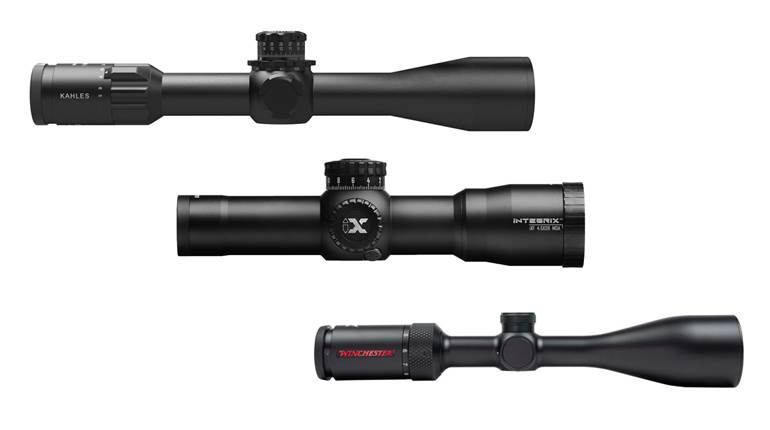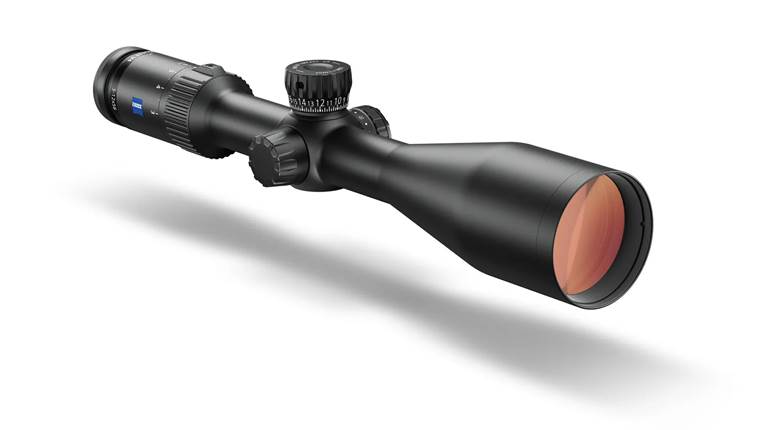
Leupold Tactical’s Mark 8 riflescope was built to provide military and law-enforcement users with an optic that will not fail, no matter the size of the rifle or the range between it and its target. Aware that some sizable government contracts have gone to other makers such as Nightforce and Schmidt & Bender recently, Leupold spared no expense on its new riflescope; as such, its price tag might alarm all but the federal government. It’s the culmination of the American company’s 107 years of building precision optics.
This 3.5-25X 56 mm optic features an illuminated reticle located in the first focal plane, innovative target turrets, side focus, Leupold’s patented Index Matched Lens System and premium lens coatings. Its 8X power range is nothing short of revolutionary. At 3.5X it could be used for CQB in a pinch, while its 25X top end is about as high as can be feasibly used in real-world conditions. All this was accomplished while maintaining eye relief of a measured 4.1" at 3.5X and 3.55" at 25X, which is greater than company literature lists. This was accomplished with an oversized eyebox containing cutting-edge optical engineering, about which Leupold reveals little.
The first thing you’ll notice when you hoist the scope, however, is its size. Simply put, it’s monstrous. It weighs 37 ozs. with its 16", 35 mm main tube and 3.5" width at the turrets. Clearly, a hunting scope it is not. So, why would anyone want such a behemoth when the company’s Mark 4 scope is battle-tested yet weighs a pound less?
First, the larger main tube allows room for more travel of the erector tube suspended within it, which means greater adjustment range. The Mark 8 has 90 m.o.a. of elevation adjustment and 50 m.o.a. for windage. A large adjustment range is not a big deal until it’s actually needed, and then it can mean the difference between mission accomplished and mission failure.
Secondly, as sniping distances have increased in the mountains and deserts of the Middle East, rifle calibers have mirrored them. There is a tremendous amount of torque placed on a scope as a cartridge in the .338 Lapua Mag. or .50 BMG class reaches peak chamber pressure. The Mark 8’s tubes feature thicker walls that are specifically designed to endure the repeated pounding of such guns. For a rifle weighing 20 to 30 lbs. already, what’s another pound if it offers insurance against failure?
Lastly, bigger lenses are needed with ultra-high magnification. When light is directed through glass, some of it is lost to reflection. All things being equal, however, a scope’s brightness is largely dependent on the size of its exit pupil, which is derived from the objective lens diameter being divided by its magnification. The human eye is capable of only dilating 5-7 millimeters—so any exit pupil greater than that is wasted light. Due to its 56 MM objective, the Mark 8 has an exit pupil of only 2.24 mm at 25X. Still, that is a usable amount of light in most conditions.
To maximize its low-light performance, Leupold used its Index Matched Lens System, wherein glass is tested, sorted, matched and multi-coated to optimize it for the spectrum of light deficient in human eyes. While non-mechanical evaluation is subjective, the Mark 8 is among the brightest riflescopes we have ever tested.
Like most serious mil-dot-based reticle systems, the Mark 8’s is placed in the first focal plane so subtensions remain constant throughout the power range. Three reticle choices are available, including Mil-Dot, Horus Vision’s H-58 and Leupold’s version of the Horus, called TREMOR 2. The latter two are especially useful in scenarios that call for wind holds or elevation hold-overs. All three reticles glow red on demand with Leupold’s 3rd generation illumination system. It features seven levels of brightness with an off stop between each. The scope’s circuitry is powered by one CR2032 battery.
Perhaps more engineering went into the Mark 8’s dials than anything. Long range shooters need turrets they can dial quickly by feel and sound while keeping their eyes on target. But a target range is different from a battlefield where the earth shakes, rifles get tossed and zeroes get lost. Leupold’s remedy for quick yet secure adjustment is its M5B2 system that it describes as “auto-locking pinch-and-turn” dials. Two half-moon-shaped metal rings form a circle around the knob and must be squeezed simultaneously to turn it—a natural hand movement that must be done anyway. When pinch-pressure ceases, the rings expand to lock the turret in place. It’s an effective solution. However, there was concern that the rings could be impacted with debris and jammed, so it was tested by mashing it full of icy snow. The turrets remained functional.
Each click of the turret results in 0.1 milliradian of reticle movement, a measurement that simplifies use of the mil-dot reticle. Clicks are positive, tactile, and more importantly, accurate and repeatable. Leupold’s Twin Bias Spring Erector System that utilizes leaf-type springs is touted to increase erector holding force by 30 percent over single-spring systems. To test durability, a 7-lb., 8-oz. rifle in .338 Win. Mag. did not shift the scope’s zero. The Mark 8 proved its repeatability by shooting the box.
The turrets feature a zero stop so shooters can quickly return to zero without looking. After it is set via hex nut, two retaining pins allow the indicator ring to slide up and spin so its numbered marks coincide with the zero for quick indexing. Additionally, a revolution indicator in the elevation turret reveals when a complete revolution of 10 mils is made. This combats getting "lost” in the adjustments.
To conclude testing, the scope was left outside overnight in minus 2º F weather; it was submersed for an hour in warm water; and dropped 5 times on grassy ground from a distance of 4 ft. Nothing fazed the Mark 8—unsurprising given Leupold’s reputation for high-quality optics.
Given its $5,000-plus price, the Mark 8 3.5-25X 56 mm isn’t within the budget of most shooters; however, for those who can—and are willing to—part with funds will get the best of what Leopold has to offer.
Manufacturer: Leupold & Stevens, Inc., 14400 N.W. Greenbrier Parkway, Beaverton, OR 97006; (800) 538-7653; leupold.com
Reticle: first focal plane; mil-dot (tested); H-58; TREMOR 2
Lens Coating: Index Matched Lens System with Diamond Coat 2
Adjustment Markings: M5B2 auto-locking pinch and turn turrets; 0.10 mil and 10 mils per revolution with revolution indicator
Main Tube Diameter: 35 mm
Magnification: 3.5-25X
Field of View: 32.5 ft.-4.4 ft. @ 100 Yds.
Exit Pupil: 16 mm-2.24 mm
Weight: 37 ozs.
Length: 16"
Objective Aperture: 56 MM
Eye Relief: 4.1" – 3.5" (tested)
Elevation Adjustment Range: 90 m.o.a.
Windage Adjustment Range: 50 m.o.a.
Click Value: 0.10 mil
Accessories: owner’s manual, one CR2032 battery
Suggested Retail Price: $5,375 Mil-Dot; $5,875 H-58 or TREMOR 2 reticle




































